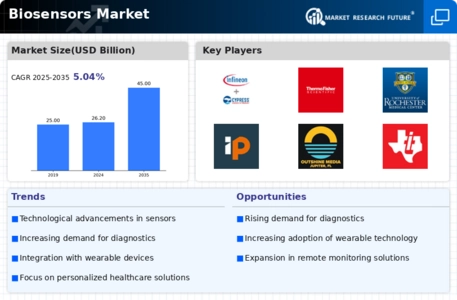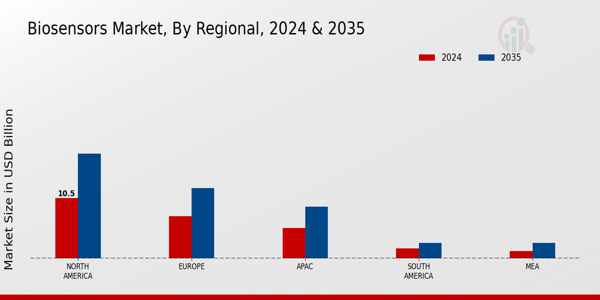Market Growth Projections
The Global Biosensors Market Industry is projected to experience substantial growth over the next decade. With a market valuation of 26.2 USD Billion in 2024, it is anticipated to reach 45 USD Billion by 2035. This growth trajectory suggests a compound annual growth rate of 5.04% from 2025 to 2035. Factors contributing to this expansion include technological advancements, increasing demand for point-of-care testing, and the rising prevalence of chronic diseases. The market's evolution reflects a broader trend towards more efficient and effective healthcare solutions, positioning biosensors as a pivotal component in future medical diagnostics and monitoring.
Technological Advancements
The Global Biosensors Market Industry experiences rapid growth due to continuous technological advancements. Innovations in microfabrication and nanotechnology enhance the sensitivity and specificity of biosensors, making them more effective for various applications. For instance, the integration of wireless technology allows for real-time monitoring of health parameters, which is particularly beneficial in remote patient management. As of 2024, the market is valued at approximately 26.2 USD Billion, with projections indicating a rise to 45 USD Billion by 2035. This growth reflects a compound annual growth rate of 5.04% from 2025 to 2035, underscoring the importance of technological progress in driving market expansion.
Government Initiatives and Funding
Government initiatives and funding play a crucial role in the development of the Global Biosensors Market Industry. Various governments worldwide are investing in research and development to promote innovation in biosensor technology. These initiatives often focus on enhancing healthcare delivery and improving patient outcomes. For instance, funding programs aimed at supporting startups and research institutions contribute to the advancement of biosensor applications in medical diagnostics and environmental monitoring. Such governmental support is likely to accelerate market growth, helping the industry transition from a valuation of 26.2 USD Billion in 2024 to an anticipated 45 USD Billion by 2035, with a CAGR of 5.04% from 2025 to 2035.
Rising Demand for Point-of-Care Testing
The increasing demand for point-of-care testing significantly influences the Global Biosensors Market Industry. Patients and healthcare providers favor rapid diagnostic solutions that can be administered outside traditional laboratory settings. This shift is particularly evident in chronic disease management and infectious disease detection, where timely results are crucial. The convenience and efficiency of biosensors in providing immediate feedback on health status are driving their adoption. As the market evolves, the emphasis on point-of-care solutions is expected to contribute to the projected growth from 26.2 USD Billion in 2024 to 45 USD Billion by 2035, reflecting a CAGR of 5.04% from 2025 to 2035.
Increasing Prevalence of Chronic Diseases
The Global Biosensors Market Industry is significantly impacted by the rising prevalence of chronic diseases, such as diabetes and cardiovascular disorders. These conditions necessitate continuous monitoring and management, which biosensors facilitate effectively. For example, glucose monitoring systems have become essential for diabetes management, allowing patients to track their blood sugar levels conveniently. The growing population of individuals with chronic conditions is likely to drive the demand for biosensors, contributing to the market's expansion. With a valuation of 26.2 USD Billion in 2024, the industry is projected to reach 45 USD Billion by 2035, indicating a robust CAGR of 5.04% from 2025 to 2035.
Growing Awareness of Personalized Medicine
The Global Biosensors Market Industry is increasingly influenced by the growing awareness of personalized medicine. As healthcare shifts towards tailored treatment approaches, biosensors are becoming integral in monitoring individual responses to therapies. This trend is particularly relevant in oncology, where biosensors can provide real-time data on tumor markers, enabling more effective treatment decisions. The emphasis on personalized healthcare solutions is driving the demand for biosensors, which are capable of delivering precise and timely information. This market evolution is expected to support the growth trajectory from 26.2 USD Billion in 2024 to 45 USD Billion by 2035, reflecting a CAGR of 5.04% from 2025 to 2035.






















Leave a Comment